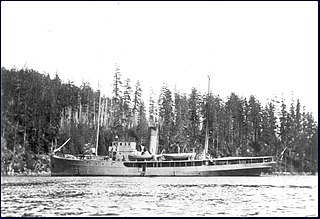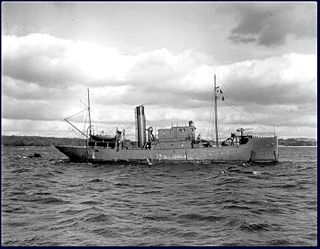
HMCS Galiano was a Canadian government fisheries patrol vessel pressed into service with the Royal Canadian Navy in 1917 during the First World War. Used for patrol and assessment duties on the West Coast of Canada, Galiano disappeared in a storm in October 1918, making her Canada's only warship lost during the First World War.

HMCS Arleux was one of twelve Battle-class naval trawlers used by the Royal Canadian Navy (RCN). Entering service in 1918 near the end of the First World War, the vessel had a short career with the RCN, being transferred to the Department of Marine and Fisheries in 1922. Arleux was used for fisheries patrol off the east coast of Canada until 1939, when the ship was reacquired by the RCN at the onset of the Second World War. Used as a gate vessel during the war and designated Gate Vessel 16, the ship was sold for mercantile purposes following the war. The ship foundered in 1948 off the coast of Nova Scotia.

HMCS Armentières was one of twelve Battle-class naval trawlers used by the Royal Canadian Navy (RCN). Armentières entered service in 1918 near the end of the First World War on the Atlantic coast of Canada. Following the war, the ship was transferred to the Department of Marine and Fisheries for a short period before reverting to RCN service in 1923 on the Pacific coast of Canada. The ship sank in 1925, was raised and re-entered service, remaining with the fleet through the Second World War as an examination vessel at Prince Rupert, British Columbia. After the end of the war, the vessel entered mercantile service becoming A.G. Garrish in 1947, later renamed Arctic Rover in 1958, Laforce in 1962 and Polaris in 1973. The ship's registry was deleted in 1991.

HMCS Arras was one of twelve Battle-class naval trawlers that saw service with the Royal Canadian Navy (RCN). The vessel entered service in 1918 near the end of the First World War and was used for patrolling and escort duties along the Atlantic Coast of Canada. Following the war, Arras was transferred to the Department of Marine and Fisheries where the ship was used as a fisheries patrol vessel. Following the outbreak of the Second World War, the ship re-entered RCN service as a gate vessel. In 1943, the ship was heavily damaged by fire and was broken up in 1957.

HMCS Givenchy was one of twelve Battle-class naval trawlers constructed for and used by the Royal Canadian Navy (RCN) during the First World War on the east coast. Following the war, the ship was transferred to the Department of Marine and Fisheries for use as a fisheries patrol vessel on the west coast. Givenchy reentered service with the RCN in 1939 as an accommodation ship during the Second World War and was recommissioned from 1940 to 1943. After the war the ship was sold and broken up in the United States in 1952.

HMCS Loos was one of twelve Battle-class naval trawlers used by the Royal Canadian Navy (RCN). Built by the Kingston Shipbuilding Company and launched in September 1917, she was commissioned in August 1918. Decommissioned in 1920, Loos was transferred to the Department of Marine and Fisheries, where she was used as a lighthouse supply ship. Sold in 1937, she was re-acquired by the RCN in December 1940 and converted to a gate vessel, spending part of the war at Shelburne, Nova Scotia. Returned to Marine Industries Limited in 1945, Loos was broken up in 1949.

HMCS Thiepval was one of twelve Battle-class naval trawlers used by the Royal Canadian Navy (RCN). After seeing service on Canada's east coast at the end of the First World War, Thiepval was transferred to the west coast, where she spent the remainder of her career. In 1924, Thiepval visited the Soviet Union and Japan as part of the support efforts for a round-the-world flight attempt. Thiepval struck a rock and sank off the British Columbia coast in 1930, and her wreck has since become a popular attraction for divers.

HMCS Messines was one of twelve Battle-class naval trawlers constructed for and used by the Royal Canadian Navy (RCN) during the First World War. Following the war the ship was transferred to the Canadian Department of Marine and Fisheries and converted into a lightvessel. Re-designated Lightship No. 3, the vessel was sold for scrap and broken up in 1962.

HMCS Festubert was one of twelve Battle-class naval trawlers constructed for and used by the Royal Canadian Navy (RCN) during the First World War. Following the war, Festubert remained in Canadian service as a training ship until 1934. Reactivated for the Second World War, the ship was used as a gate vessel in the defence of Halifax, Nova Scotia and re-designated Gate Vessel 17. Following the war, the trawler was sold for commercial use and renamed Inverleigh. Inverleigh was scuttled off Burgeo, Newfoundland on 30 June 1971.

HMCS Ypres was one of twelve Battle-class naval trawlers constructed for and used by the Royal Canadian Navy (RCN) during the First World War. Named after the Second and Third battles of Ypres, the ship entered service in 1918, patrolling the east coast of Canada for submarine activity. Following the war, the ship remained in service with as a patrol and training ship. In 1938, the vessel recommissioned as a gate vessel, re-designated Gate Vessel 1, in service at Halifax, Nova Scotia. On 12 May 1940, the gate vessel was rammed and sunk in a collision with the British battleship HMS Revenge.

HMCS Vimy was one of twelve Battle-class naval trawlers constructed for and used by the Royal Canadian Navy (RCN) during the First World War. Following the war the ship was transferred to the Canadian Department of Marine and Fisheries and converted into a lightvessel. Re-designated Lightship No. 5, the vessel remained in Canadian government service until being possibly broken up for scrap in 1958.

HMCS St Julien was one of twelve Battle-class naval trawlers constructed for and used by the Royal Canadian Navy (RCN) during the First World War. Following the war the ship was transferred to the Canadian Department of Marine and Fisheries and converted into a lightvessel. Re-designated Lightship No. 22, the ship remained as such until 1958. The ship was sold for commercial use and renamed Centennial and was in service until 1978.

HMCS St. Eloi was one of twelve Battle-class naval trawlers constructed for and used by the Royal Canadian Navy (RCN) during the First World War. Following the war the ship was transferred to the Canadian Department of Marine and Fisheries and converted into a lightvessel. Re-designated Lightship No. 20, the vessel returned to RCN service in 1940 to become the gate vessel Gate Vessel 12 during the Second World War. After the war, the trawler returned to government service and was discarded in 1962.

HMCS Gulnare was a Canadian government ship that served as a patrol boat and guard vessel for the Royal Canadian Navy (RCN) during the First World War. Acquired by the Canadian government in 1902, Gulnare was used for fisheries patrol and hydrographic survey duties until 1914. Following the war, Gulnare was used to intercept smugglers. Returned to government service in 1920, the vessel was converted to a lightship in 1925 and sold in 1937 to private interests. The vessel was broken up for scrap in the late 1940s.

HMCS Stadacona was a commissioned patrol boat of the Royal Canadian Navy (RCN) that served in the First World War and postwar until 1920. Prior to entering service with the RCN, the vessel was the private yacht Columbia. Following the war, Stadacona performed hydrographic surveys. The vessel was sold for commercial use in 1920 and was burned for salvage in 1948. Stadacona is a historic name associated with Canada, the voyages Jacques Cartier, the colony of Samuel de Champlain, and Quebec City.

HMCS Constance was a commissioned minesweeper of the Royal Canadian Navy (RCN) during the First World War. Originally built as a fisheries cruiser for the Department of Marine and Fisheries, upon completion she was transferred to the Department of Customs, and was used by the Customs Preventive Service. Constance spent the entire war as a patrol and examination vessel on the East Coast of Canada. Following the war, the vessel was sold in 1924.

HMCS Curlew was a commissioned minesweeper and patrol vessel of the Royal Canadian Navy (RCN) that served in the First World War. Constructed in Ontario in 1892, Curlew was initially a Canadian government fisheries patrol vessel on the East Coast of Canada. In 1912, the ship was fitted as a minesweeper and in 1914, joined the RCN. Curlew spent the entire war on the East Coast of Canada. Following the war, the ship was taken out of service and sold in 1921.

CGS Vigilant was a Fisheries Protection patrol vessel employed on the Canadian Great Lakes. Completed in 1904, the vessel remained in service on the Great Lakes until 1924. The vessel was then chartered by the Canadian Customs Preventive Service until 1929 for service on the East Coast of Canada. The ship was sold to private interests and converted to a barge and remained in service until 1956 when the vessel was broken up.

CGS Petrel was a Canadian patrol vessel used primarily for fisheries protection on the upper Great Lakes from 1892 to 1904. In 1904, Petrel was sent to the East Coast of Canada for fisheries protection duties there. In 1912, Petrel was fitted for minesweeping and in 1914, was taken over by the Royal Canadian Navy for use as an examination vessel during the First World War. Following the war, Petrel was discarded.




















